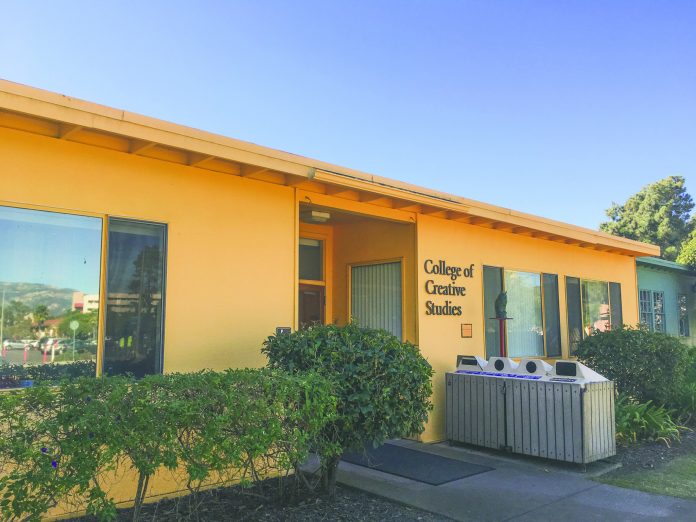Annette Ding
The College of Creative Studies (CCS) has entered its 50th year at the University of California, Santa Barbara.
From its roots as a small experimental college in the 1960s, CCS has thrived over the years as a concentrated academic institution in a large public university like UCSB.
In the 1960s, Chancellor Vernon I. Cheadle appointed Professor Marvin Mudrick of the English Department to drum up ideas for a new program.
Cheadle’s intention was to create an institution in line with the time’s creative spirit and a desire to distinguish UCSB from other UC campuses. Mudrick later became CCS’ first provost.
The result was the college’s establishment, in 1967, for students who were “triangle or square pegs in a world of round holes, who had really strong urge and focus to pursue their particular intellectual endeavor,” Professor Bruce Tiffney told The Bottom Line.
Tiffney served as the Dean of CCS from 2005 to 2016.
CCS is currently comprised of 373 students across eight different majors: mathematics, biology, physics, chemistry, writing and literature, music composition, art, and computer science, with an 8-to-1 faculty-to-student ratio.
Twenty percent of the UCSB Regents’ Scholars is composed of CCS students, according to the UCSB Current. 75 percent go on to pursue graduate school, the Current reported.
A major contributing factor to the birth of CCS was strong support from UCSB faculty, Tiffney said.
During the early days, when UCSB was not quite so distinguished, “a fair number of faculty got behind the idea of CCS — precisely so that they could attract really good students to UCSB,” Tiffney said. “So in the early history of the college there was broad participation of faculty across campus in the college.”
CCS encountered problems along the way, Professor William Ashby told The Bottom Line.
“When I came into the college, the enrollment was kind of precarious,” Ashby said. “I think we were down to about 128 students at one point and people were questioning the viability of the college.” Ashby served as CCS Provost between 1972 and 2005.
As UCSB grew in renown, funding, and research, the same faculty that had backed, and participated in CCS was increasingly more engaged in research commitments, Tiffney said.
There were more students in the other UCSB colleges. Another issue was CCS’s own privacy, as it “tried to keep sort of hidden from the rest of the campus, to do its own thing and be as little involved as possible,” Ashby said.
As time went on, CCS integrated more. Somewhere in the late 1980s, the UCSB physics department decided to develop a high-level program through CCS, Tiffney said.
The program was more structured than what CCS had before. This allowed UCSB to advertise the physics department to undergraduates at a national level, Tiffney said.
“It tied the CCS physics program to the College of Letters and Science physics program,” Tiffney said, so physics enrollment began to take an upward trajectory again. Other departments caught on.
The effect turned out to be “successful for the college and UCSB as a whole,” Ashby said.
Now, instead of hiring faculty on a year-by-year basis, CCS now has “master lecturers” — professors who are shared between CCS and other campus departments, according to Kathleen Foltz, interim Dean of the CCS.
As the college has developed, the college began to nurture students with “early passions,” students who know exactly what they want to pursue, Foltz said.
“This is a good place for them because they can just immerse instantly,” Foltz said.
For CCS student Michael Wintermantel, a third year biology major, CCS has lived up to his expectations. Since age five, Wintermantel has wanted to study marine biology.
“Probably the best decision I ever made,” Wintermantel said. “Over the moon basically, it’s been.”
In addition to assigning one faculty advisor to each CCS student for their undergraduate career, CCS actively encourages students to seek out research opportunities. Wintermantel has been involved in the Burkepile Lab studying coral reefs since his first year at UCSB. This year, he will also join the Eliason Lab researching physiology and ecology.
Some perks of being a CCS student are more mundane. According to Yunkai Zhang, a second year mathematics major, “the best thing about CCS is the unlimited printing.”
For its 50th anniversary, CCS will host its first annual Research and Creative Activity Conference on Nov. 4. Students will give short presentations on their research and original works.
In addition, UCSB alumni will give keynote speeches. The speakers include Emmy Award-winner and CCS literature major Parry Gripp (class of 1992), as well as astrophysicist and CCS physics major Alex Filippenko (class of 1979).
UPDATE:
Nov. 1, 4:12 p.m.: A previous version of the story identified a professor as Gregory Ashby. The professor’s name is William Ashby. The previous version listed the College of Creative Studies’ year of formation as 1976. CCS was established in 1967.











